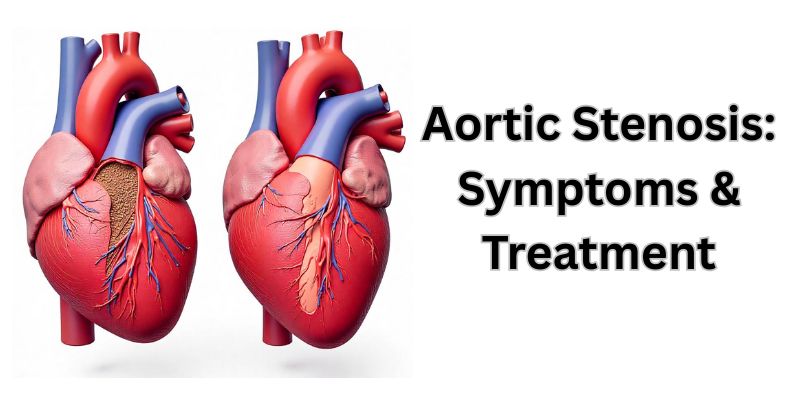
Aortic-Stenosis
Aortic stenosis is a serious heart condition in which the aortic valve, responsible for regulating blood flow from the heart’s left ventricle to the aorta, narrows and restricts blood flow. This narrowing can result from congenital issues, age-related wear and tear, or a buildup of calcium deposits over time. If left untreated, aortic stenosis symptoms can worsen, leading to serious complications, such as heart failure or even death. Understanding the symptoms and available aortic stenosis treatment options is crucial for timely diagnosis and effective management of the condition.
Aortic Stenosis Symptoms
The aortic stenosis symptoms can range from mild to severe, depending on how much the valve is narrowed. Many people with early-stage aortic stenosis may not experience noticeable symptoms. However, as the condition progresses, symptoms may begin to manifest and become more severe. Here are some common aortic stenosis symptoms to watch out for:
- Chest Pain (Angina): As the narrowing of the aortic valve restricts blood flow to the heart, the heart muscles may not receive enough oxygenated blood, causing chest pain or discomfort. Angina often feels like a heavy, tight, or squeezing sensation in the chest.
- Shortness of Breath: With reduced blood flow, the heart has to work harder to pump blood, leading to increased pressure in the heart and lungs. This pressure can cause fluid to accumulate in the lungs, resulting in shortness of breath, especially during physical activity or exertion.
- Fatigue: People with aortic stenosis often feel unusually tired or fatigued because the heart struggles to pump blood efficiently, limiting the oxygen supply to the body. As a result, individuals with aortic stenosis may feel lethargic or have difficulty completing everyday tasks.
- Dizziness or Fainting: In severe cases, aortic stenosis can cause a drop in blood pressure, leading to dizziness or fainting. This is particularly common when standing up quickly or engaging in physical exertion, as the heart’s ability to pump blood becomes increasingly compromised.
- Heart Palpitations: Individuals with aortic stenosis may experience irregular heartbeats or a sensation of a racing heart. This occurs due to the heart’s attempt to compensate for the limited blood flow caused by the narrowed aortic valve.
- Swelling in the Legs and Ankles: When blood flow is restricted, the body may begin to retain fluid, leading to swelling, particularly in the lower extremities.
If you experience any of these symptoms, especially if they worsen over time or occur during physical activity, it is essential to seek medical attention immediately. Early diagnosis of aortic stenosis is key to preventing complications and improving outcomes.
Aortic Stenosis Treatment
The treatment for aortic stenosis depends on the severity of the condition and the overall health of the individual. There are various treatment options available to manage symptoms, prevent complications, and improve the quality of life for those affected by the condition. The goal of aortic stenosis treatment is to relieve symptoms, improve heart function, and prevent further damage to the heart.
1. Monitoring and Medications
In the early stages of aortic stenosis, when symptoms are mild, doctors may recommend a watchful waiting approach. This involves regular monitoring of the condition through imaging tests, such as echocardiograms, to assess the progression of the valve narrowing. While no specific medications can reverse the narrowing of the valve, doctors may prescribe medications to help manage symptoms and reduce the strain on the heart. These may include:
- Diuretics: These medications help reduce fluid buildup in the body, relieving symptoms of swelling and shortness of breath.
- Beta Blockers: These drugs help lower heart rate and blood pressure, allowing the heart to work more efficiently.
- ACE Inhibitors or ARBs: These medications can help manage high blood pressure, which can worsen aortic stenosis symptoms.
However, as the condition progresses and symptoms become more severe, more invasive treatments may be necessary.
2. Surgical Treatment: Aortic Valve Replacement (AVR)
The most effective aortic stenosis treatment for severe cases is surgery to replace the narrowed aortic valve. Aortic valve replacement (AVR) is the gold standard treatment for symptomatic individuals with severe aortic stenosis. There are two primary types of valve replacements:
- Mechanical Valve Replacement: This type of valve is made from durable materials like carbon or metal and is designed to last for many years. However, people with mechanical valves need to take blood-thinning medications for life to prevent blood clots.
- Biological Valve Replacement: This valve is made from animal tissue (usually from pigs or cows) and may not last as long as a mechanical valve. However, biological valves do not require long-term use of blood thinners.
The choice of valve type depends on the patient’s age, health condition, and preferences, as well as the surgeon’s recommendation.
3. Minimally Invasive Procedures
For patients who are not candidates for traditional open-heart surgery due to other health conditions or age, there are less invasive procedures available to treat aortic stenosis. One such procedure is transcatheter aortic valve replacement (TAVR), which involves inserting a new valve through a catheter that is threaded through the blood vessels to the heart. TAVR is less invasive than traditional surgery and has a shorter recovery time, making it an excellent option for high-risk patients.
4. Balloon Valvuloplasty
In some cases, a procedure known as balloon valvuloplasty may be used to treat aortic stenosis. This procedure involves inserting a catheter with a balloon at the tip into the narrowed valve. The balloon is inflated to widen the valve opening, temporarily relieving symptoms. However, this treatment is typically used in younger patients or those who are not candidates for surgery. The effects of balloon valvuloplasty are usually temporary, and it is not a long-term solution.
Conclusion
Aortic stenosis is a progressive condition that can lead to severe complications if left untreated. Recognizing aortic stenosis early on is crucial for seeking timely medical intervention. Treatment options, such as medication, valve replacement surgery, or minimally invasive procedures, are available to manage the condition and improve the patient’s quality of life. It is important to consult a cardiologist for an accurate diagnosis and appropriate aortic stenosis treatment to prevent serious heart complications and ensure optimal outcomes.
for more(click here)






